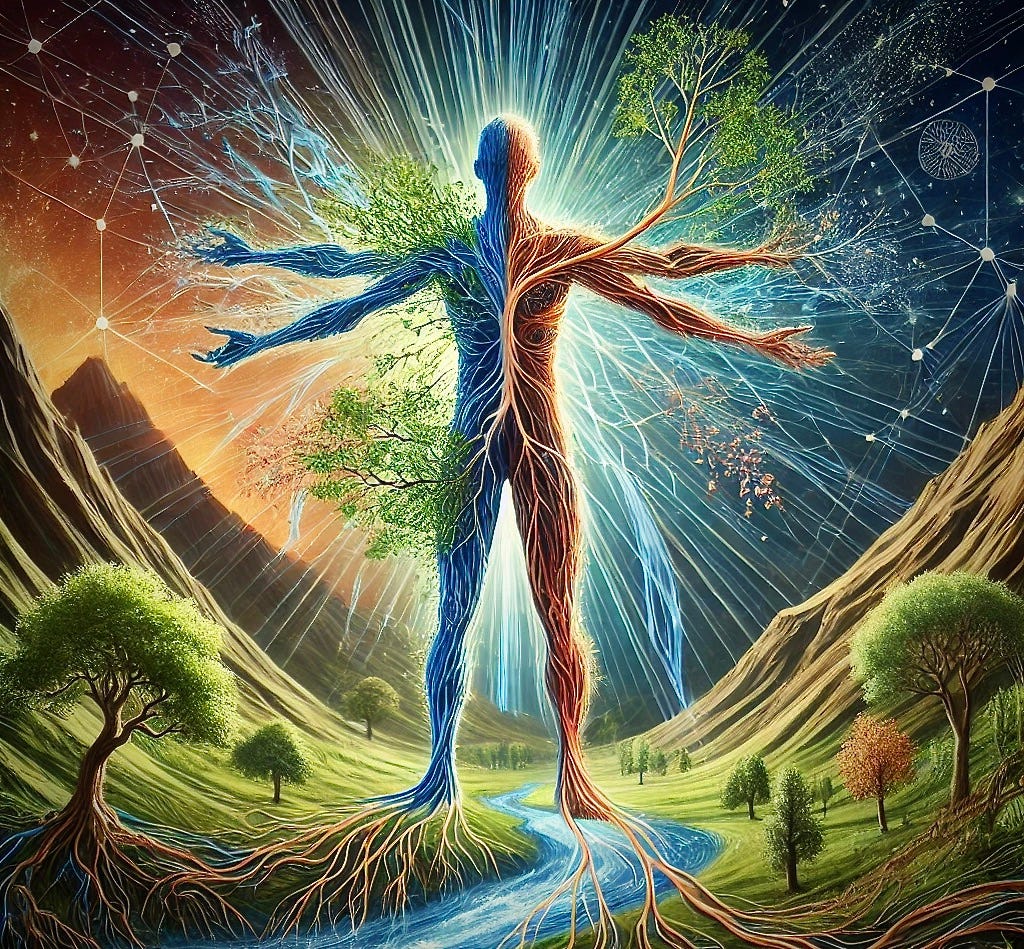"...a culture that alienates itself from the very ground of its own being—from wilderness outside (that is to say, wild nature, the wild, self-contained, self-informing ecosystems) and from that other wilderness within—is doomed to a very destructive behavior, ultimately perhaps self-destructive behavior." ~ Gary Snyder
To move is to be alive. To be alive is to be in relational movement with the thick web of intertwined, multi-layered natural ecosystems of this wild world. The nature of movement and the movement of nature, at its core, form an ongoing dialogue between our bodies and the living earth. In every step, breath, and shift of weight, we are participants in a dynamic exchange with the forces that shape us—gravity, water, air, and the pulsing rhythms of life.
Contemporary life often dulls our awareness of these fundamental connections. Constrained by visible and invisible rigid structures—both physical and conceptual—we lose touch with the natural fluidity that defines both our bodies and the world around us. When we return to the wild—fully functioning diverse ecosystems—immersing ourselves in the unfiltered landscapes of mountains, forests, rivers, oceans, and open sky, something ancient stirs within the interconnected ecosystems of our animal body. We remember, in a felt and tangible way, that we are not separate from nature—we are nature.
Pause for a moment and let this in—we are not separate from nature—we are nature.
Call of the Wild
Now, more than ever, is the time to deepen our connection, understanding, and relationship with ourselves, others, and the natural world. If the human experiment is to continue, we must cultivate a deep relationship with our wild animal bodies and our connections to both the human and more-than-human world. The collective evolutionary unfolding of humanity depends on it.
From direct experience, I stand firmly in the ground that turning toward the discomfort of the multitude of challenges ahead with open awareness will lead to more appropriate and effective actions—actions that are more fully informed and responsive when we are in direct relationship with the wild.
Do we need to wait until we deepen our relationship before engaging in skillful action? Of course not. This is not an either/or choice. It is a dynamic, interwoven both/and—where the call of the wild and the call to action are growing and co-evolving together.
Awakening to the Wild
When we step into the wilderness, we enter into a sensory dialogue. The scent of damp earth after rain, the hush of wind through trees, the solidity of stone beneath our feet—each sensation invites us to come to our senses in the most literal way. This reawakening to sensation is more than just an aesthetic pleasure; it is a fundamental act of belonging.
Through perceptual and movement practices, we can cultivate a refined awareness that enhances our sensitivity to both the outer and inner fluid landscapes. Ancient movement traditions and contemporary somatic practices alike offer pathways to grounding, centering, and deepening our relationship with the greater community of being. The more we attune to these practices, the more we recognize and allow the wisdom of nature that is within us. We are participants in a shared choreography, where every breath, every gesture, is an act of embodied relationship.
Three Ways to Engage More Fully with Nature as Nature
Move with Awareness: Take time to walk, stretch, or move in nature with full attention. Feel how our body responds to the terrain, the temperature, and the textures beneath our feet. Notice how our relationship to gravity shifts in response to the landscape, and allow ourself to move with the pace of the natural world.
Practice Sensory Immersion: Engage all our senses when we step outside. Close our eyes and listen deeply to the sounds around us. Run our fingers over the bark of a tree, the surface of a rock, or the movement of water. Inhale the scent of the air and allow our senses to be fully present in the moment.
Cultivate a Daily Relationship with the Wild: We don't need to be deep in the backcountry to engage with the living world. Find ways to connect daily—whether it's watching the shifting patterns of clouds, feeling the wind on our skin, or learning the plants, animals, and birds that live with us. Recognizing the presence of the wild in daily life fosters an ongoing relationship with the pulsing rhythms of life.
When we wakefully open ourselves to movement, sensation, and direct experience of the inner and outer wilds, we rediscover our place in the wild community of life—an ancient kinship. In doing so, we do not merely visit nature—we remember that we are nature, embodied and pulsing with aliveness.
Now, for fun and for moving our bodies!




